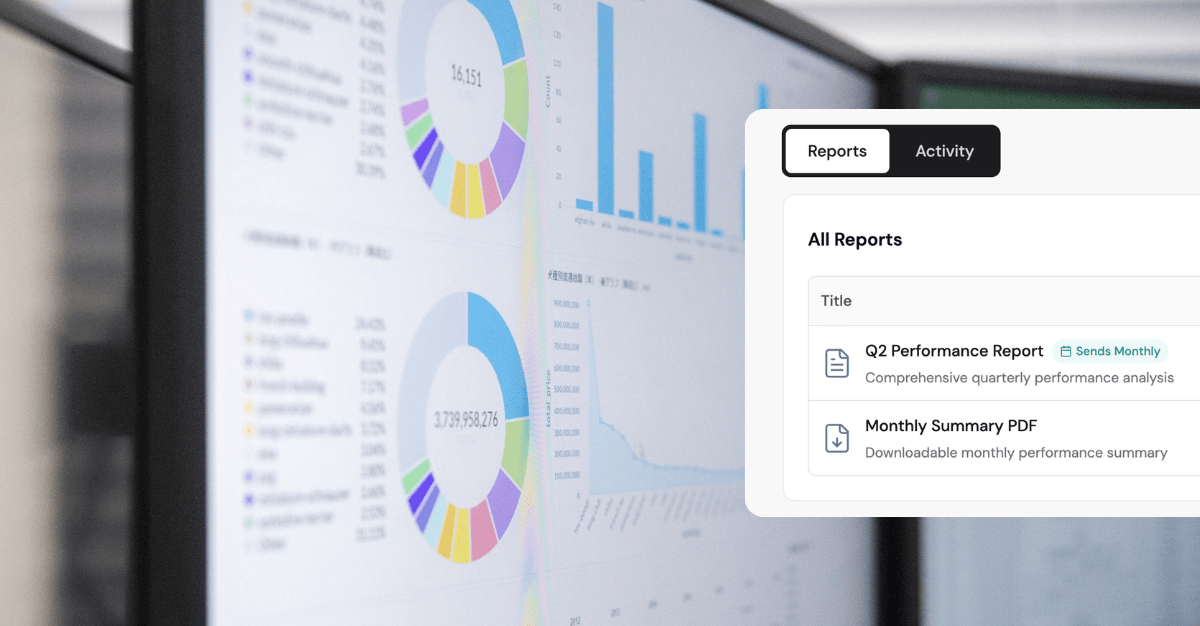How to Automate Client Reporting Without Losing the Human Touch
Automate your client reporting without losing the personal touch. Learn how agencies can save hours and still deliver branded, insightful reports clients value.
Gideon Banks
••5 min readMarketing Analytics Expert

Client reporting is one of the most important and time-consuming responsibilities agencies face. Clients want answers: What’s working? What’s not? Where should we focus next? They expect consistent, professional updates that are accurate, clear, and timely.
Behind every clean report, however, is a maze of tools, tabs, exports, formatting, and last-minute commentary. Multiply that across five, ten, or twenty clients. The time and energy required increases fast, turning reporting into a draining weekly ritual. Even if you’ve streamlined parts of it, chances are you’re still spending hours trying to get everything aligned.
Naturally, automation sounds like the obvious solution. But if you’ve ever received a lifeless, generic auto-generated report, you already know what that experience feels like, cold, robotic, and disconnected. And clients feel it too.
So how do you streamline and scale your reporting process without making it feel cold or impersonal? How do you save time without losing the human touch your clients genuinely value?
That’s what this post is here to answer.
Why Agencies Are Stuck in Reporting Chaos
Agencies spend hours (sometimes full days) every week just producing clean, client-ready reports. In fact, a recent survey by Databox found that over 60% of marketers spend more than four hours per client on reporting tasks alone. You’ve likely experienced some of these recurring steps:
- Logging into multiple platforms to pull performance data
- Copying metrics into spreadsheets or slides
- Designing charts and tables to make the numbers readable
- Writing custom commentary from scratch under deadline pressure
This isn’t just inefficient—it’s a bottleneck. Manual, inconsistent reporting eats into your team’s time, affects the quality of insights, and leaves little room for strategic work. Clients might not see this effort, but they can feel the inconsistency.
When reports look rushed, templated, or impersonal, they question how much care is going into the work, even when your results are solid.
What to Automate (And What Not To)
The purpose of automation isn’t to remove people. It’s to remove the repetitive, low-value tasks that take time away from the work that truly matters: insights, context, and communication.
Here’s a breakdown:
Automate:
- Data collection from Google Analytics, Ads, Meta, LinkedIn, Search Console, and other platforms
- Formatting and dashboard design, including charts, graphs, and tables
- Recurring report delivery, sent as PDFs or live dashboards via email or shareable links
Don’t automate:
- Strategic commentary on what the data means
- Client-specific takeaways or recommendations
- Context behind unusual performance, such as spikes or dips
Let automation handle the grunt work. That way, you have more time to craft thoughtful, client-specific insights—the kind they remember and value.
Why Branded Reporting Still Matters
Automation shouldn’t feel generic. Clients expect more than just accurate data, they expect a professional, consistent, and branded experience.
A white-labelled report featuring your agency’s logo, colours, and voice adds credibility. It signals care, polish, and professionalism. More importantly, it reinforces trust.
Even the small details matter: consistent naming conventions, clean formatting, and predictable report structures. Modalboard helps ensure these details are managed consistently across clients so your reports always reflect your brand’s quality and attention to detail. Remember, the visual experience sets the tone before any numbers are reviewed.
How Modalboard Helps You Automate Without Losing the Human Touch
Modalboard was built to solve this exact challenge: helping agencies deliver fast, scalable reports without losing the personalised insights clients rely on. Whether you’re juggling 15 client accounts or reporting to a busy CMO, Modalboard saves you time while reinforcing trust.
Here’s how:
- Automatic data integration: Connect your sources once, and Modalboard keeps them synced
- Branded dashboards and reports: Apply your logo, colours, and fonts to all reports
- Human-first customisation: Add commentary, tag team members, or highlight results before sharing
- Flexible delivery: Export to PDF, share secure live links, or schedule email delivery
- Reusable templates: Use smart defaults and adapt for each client without starting from scratch
You’ll save hours per client each week while delivering reporting that feels thoughtful, customised, and professional.
5 Tips to Keep Reports Personal (Even When Automated)
- Set client-specific KPIs and reuse them to ensure consistency.
- Include short commentary or highlights in each report, even a sentence or two adds value.
- Reference goals or recent conversations to make reports feel relevant and personalised.
- Use natural, human language—avoid technical jargon or robotic phrasing.
- Supplement automation with a personal check-in, such as a Loom video or quick call every quarter.
Automation Should Amplify You, Not Replace You
Your clients don’t hire you to copy and paste numbers. They hire you for your insight, judgement, and strategic thinking.
The right automation doesn’t replace that, it protects it. By clearing away time-consuming admin tasks, Modalboard helps you focus on the work that matters most.
Automate smarter. Keep your reports clear, consistent, and distinctly human.
Ready to automate smarter?
Try Modalboard and start sending better reports with less effort. Simplify your reporting. Keep your human edge.
Gideon Banks
•Marketing Analytics Expert

